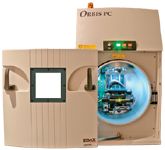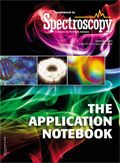Elemental Analysis Through a Plastic Barrier
Application Notebook
Demonstration of the advantages of using the Orbis micro-XRF elemental analyzer rather than other analysis techniques to perform elemental analysis through a plastic barrier and/or at atmospheric pressure.
Demonstration of the advantages of using the Orbis micro-XRF elemental analyzer rather than other analysis techniques to perform elemental analysis through a plastic barrier and/or at atmospheric pressure.
Most elemental analysis techniques require a sample to be exposed to the excitation source and/or placed under vacuum. For example, ICP-MS and atomic absorption (AA) require sample digestion or ablation and then exposure to the excitation source, while SEM-EDS requires exposure of the sample to the electron beam while under, at least, low vacuum. There are certain situations where it is highly desirable to leave the sample in a plastic barrier bag or analyze the sample at atmospheric pressure. For example, the analyst could be concerned about contamination from toxic, corrosive, or radioactive samples or may need to prevent environmental contamination of the sample. For micro-spot elemental analysis, the Orbis micro-XRF spectrometer is unique as an elemental analysis tool in that the analysis can be done through a plastic bag and, if necessary, at atmospheric pressure.
Using SEM/EDS for Analysis
- Sample must be removed from barrier bag for analysis via electron beam
- Analysis is done under vacuum conditions
- Wet sample outgassing and particle debris will put the SEM column at risk for contamination
Using ICP-MS for Analysis
- Sample must be removed from barrier bag for analysis
- Radioactively decaying materials can contaminate the equipment
In Comparison, Orbis Micro-XRF Analysis Offers an Attractive Alternative
- Analysis can be performed through a plastic barrier bag and at atmospheric pressure, facilitating the analysis of powders and slurries
- Sample targeting through the barrier bag is simple and accurate with the perpendicular analysis geometry provided by the Orbis system
- Analysis can be made on small spots to measure inclusions and defects
- Both qualitative and quantitative analysis is possible and additional features such as primary beam filters extend the analytical detection limits
Experimental Conditions
Micro-XRF is performed using X-rays as the exciting source with fluoresced X-rays characteristic of the elements present as the signal. Lighter elements (e.g. Na – Ar) fluoresce lower energy X-rays, which are more readily absorbed or scattered while traveling through a plastic barrier or through air at atmospheric pressure. Heavier elements fluoresce higher energy X-rays which experience minimal attenuation while traversing typical plastic barrier materials or the atmospheric path to the detector. Hence, where it is desirable to keep a sample in a plastic containment bag and/or analyze the sample at atmospheric pressure, micro-XRF can provide valuable elemental analysis data even if there is a trade-off on the detection limits of lighter elements.
Results
The following analytical results include: a uranium rich glass, a mining standard powder, and moon rock, all performed under varying chamber pressure and all contained using plastic bags. The conditions for each sample are briefly described. In all the samples there is signal attenuation at the lighter emissions (<4 keV) while very little at the higher emissions.
Uranium Glass Overlay
Figure 1 shows three spectra with variation in the plastic bagging. The measured concentrations of uranium were approximately 1.68 wt% using the exposed sample in air. Red is the uranium glass exposed with no barrier, blue enclosed in a single 50 μm bag, and green enclosed in two layers of 50 μm bag, for a total barrier of 100 μm. Above 4 keV there is little signal attenuation; however, below 4 keV there is distinguishable attenuation.

Figure 1: Analysis results for a uranium glass sample. Red - with no barrier; blue - enclosed in a single 50 μm bag; green - enclosed in two layers of 50 μm bag.
Mining Standard Powder
Figure 2 shows a mining sample powder of Canmet DH-1, which has a known concentration of uranium at 0.26 wt% compared with a measured concentration in the previous glass sample of 1.68 wt%. Here the red line represents the powder contained within a thinner Mylar envelope, blue within a thicker 50 μm plastic bag, and green the same 50 μm sample bag using a rhodium primary beam filter which improves lower limits of detection for the uranium X-ray lines. Both the Mylar and blue 50 μm plastic bag samples were analyzed without a filter in place. By comparing the blue and green spectra it is evident that filtering improves the peak to background for the U(Lα) line allowing for improved detection limits while using the thicker barrier plastic.

Figure 2: Analysis results for a Canmet DH-1 sample. Red - enclosed in thin Mylar envelope; blue - enclosed in 50 μm plastic bag; green - enclosed in 50 μm plastic bag using rhodium primary beam filter.
Lunar Rock
Figure 3 shows a lunar rock composed of transition elements rather than higher energy actinides. The data is represented by elemental maps instead of spectral plots. Starting from the left, these are the results from an uncontained sample, followed by samples contained with 50.8 μm nylon, 50.8 μm Teflon, and 127 μm Teflon containment bagging with analysis done in vacuum. The higher intensity color indicates stronger signal intensity with less signal absorption by the barrier material. Even using the higher density Teflon barrier material in comparison to the nylon, it is possible to efficiently analyze lower energy transition elements with the barrier in place. The goal in this case was to evaluate the impact of using increasingly stronger, gas tight containment bags on the elemental analysis via micro-XRF.

Figure 3: Analysis results for lunar rock with data represented by elemental maps.
Conclusion
The Orbis micro-XRF spectrometer has been used to provide valuable elemental analyses on samples contained within a barrier bag under atmospheric pressure and vacuum. Two capabilities have been shown here, single point analysis and elemental mapping. Where analysis of inclusions and defects or higher resolution mapping is of interest, the ultra-high intensity 30 μm polycapillary optic is particularly useful. Therefore, the Orbis PC configuration with this type of optic is recommended for this type of work. The standard hardware suite includes the primary beam energy filters used here for improved detection limits over limited spectral ranges as well as the automated stage for sample positioning and mapping. The Orbis can also be configured with two larger spot collimators along with the polycapillary optic for sample measurements more suited to a larger spot analysis.

EDAX, Inc.
91 McKee Drive, Mahway, NJ 07430
tel. (201) 529-4880, fax (201) 529-3156
Website: www.edax.com

Atomic Perspectives: Highlights from Recent Columns
March 3rd 2025“Atomic Perspectives,” provides tutorials and updates on new analytical atomic spectroscopy techniques in a broad range of applications, including environmental analysis, food and beverage analysis, and space exploration, to name a few. Here, we present a compilation of some of the most popular columns.